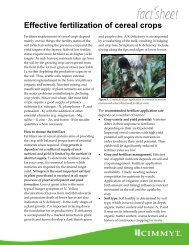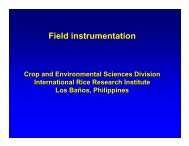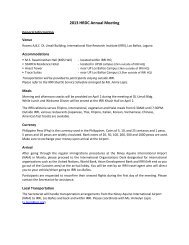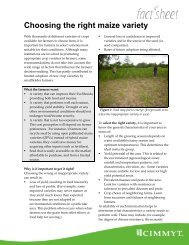the ma<strong>in</strong> system is supply-driven, farmers havecontrol over the tim<strong>in</strong>g and amount of water at thefarm gate because water is stored <strong>in</strong> small farmponds, which can also provide water for other uses(Mushtaq et al 2006).5.2 Field versus irrigation system levelThe relationships between water use at the fieldand at the irrigation system level are complex and<strong>in</strong>volve hydrological, <strong>in</strong>frastructural, and economicaspects. At the field level, farmers can reduce waterlosses by adopt<strong>in</strong>g water-sav<strong>in</strong>g technologies(Chapter 3). If they pay for the cost of the waterthey use, they can thereby <strong>in</strong>crease the profitabilityof <strong>rice</strong> farm<strong>in</strong>g. At the irrigation system level, theadoption of field-level water-sav<strong>in</strong>g technologieswill reduce the total amount of water lost as evaporation,but by relatively small amounts only. Mostof the water saved at the field level is by reducedseepage, percolation, and dra<strong>in</strong>age flows. On theone hand, this results <strong>in</strong> more water reta<strong>in</strong>ed at thesurface (<strong>in</strong> the irrigation canals), which is availablefor downstream farmers. On the other hand,it reduces the amount of water re-enter<strong>in</strong>g the hydrologicalcycle and thus reduces the options for<strong>in</strong>formal reuse downstream. Reduc<strong>in</strong>g percolationfrom <strong>rice</strong> fields can lower groundwater tables. Thiscan adversely affect yields s<strong>in</strong>ce <strong>rice</strong> plants may beless able to extract water directly from the groundwater(Chapter 1.4; Belder et al 2004). Deepergroundwater tables will also <strong>in</strong>crease the cost ofpump<strong>in</strong>g for reuse downstream. Any adoption ofwater-sav<strong>in</strong>g technologies requires considerablewater control by the farmers. This is not much ofa problem for farmers us<strong>in</strong>g their own pump, butit is so for farmers <strong>in</strong> large-scale surface irrigationsystems that lack flexibility <strong>in</strong>, and reliability of,water delivery. It is also a problem for farmers us<strong>in</strong>gelectricity to pump groundwater where supplies areunreliable, as <strong>in</strong> northwest India. To allow farmersto profit from water-sav<strong>in</strong>g technologies, suchirrigation systems need to be modernized, whichcomes at an economic cost.The “beneficiaries” of water sav<strong>in</strong>gs at thefield and irrigation system level are different <strong>in</strong> mostcases. At the irrigation system level, the irrigationsystem <strong>management</strong> can save water <strong>in</strong> agricultureand use this water for other purposes such as hydropowergeneration or <strong>in</strong>dustry. Farmers will be<strong>in</strong>terested <strong>in</strong> sav<strong>in</strong>g water only if they can derivebenefits such as reduced irrigation costs. A detaileddiscussion of motives to save water is presented <strong>in</strong>Chapter 1.7.5.3 Integrated approachesApproaches that <strong>in</strong>tegrate agronomic measures,improved policies, <strong>in</strong>stitutional reforms, and <strong>in</strong>frastructuralupgrad<strong>in</strong>gs may have the best chance ofsuccessfully respond<strong>in</strong>g to water scarcity. A recentsuccess story is the Zanghe Irrigation System (ZIS)<strong>in</strong> the middle reaches of the Yangtze Bas<strong>in</strong> <strong>in</strong> Ch<strong>in</strong>a(Loeve et al 2004a,b). ZIS has a command area ofabout 160,000 ha and services ma<strong>in</strong>ly <strong>rice</strong> <strong>in</strong> thesummer season. S<strong>in</strong>ce the early 1970s, the amountof water released to agriculture has been steadilyreduced <strong>in</strong> favor of <strong>in</strong>creased releases to cities,<strong>in</strong>dustry, and hydropower (Fig. 5.4). S<strong>in</strong>ce the mid-1990s, the amount of water received by agriculturehas been less than 30% of the amount received <strong>in</strong>the early 1970s. In the same period, however, total<strong>rice</strong> production has <strong>in</strong>creased, with a productionpeak of around 650,000 tons <strong>in</strong> the late eighties thatwas nearly twice the amount produced <strong>in</strong> the latesixties. Although <strong>rice</strong> production has leveled off toa stable 500,000 tons <strong>in</strong> the last decade, more <strong>rice</strong>has been produced with less water over the past 30years. This feat has been accomplished by a varietyof <strong>in</strong>tegrated measures (Dong et al 2004, Hong etal 2001, Loeve et al 2001, 2004a,b, Mushtaq et al2006, Moya et al 2004): Double <strong>rice</strong> cropp<strong>in</strong>g has been replaced bymore water-efficient s<strong>in</strong>gle <strong>rice</strong> cropp<strong>in</strong>g.This was possible because of the availabilityof modern short-duration high-yield<strong>in</strong>g varieties. The alternate wett<strong>in</strong>g-dry<strong>in</strong>g water-sav<strong>in</strong>gtechnology has been promoted and widelyadopted. Policies, such as volumetric water pric<strong>in</strong>g,and <strong>in</strong>stitutional reforms, such as water-userassociations, have been <strong>in</strong>troduced that driveand promote efficient use of water by farmers. The irrigation system has been upgraded (e.g.,canal l<strong>in</strong><strong>in</strong>g). Secondary storage has been developedthrough the creation of thousands of small- tolarge-size ponds and reservoirs.The ZIS case study suggests that w<strong>in</strong>-w<strong>in</strong>situations can exist where <strong>rice</strong> production can be41
<strong>Water</strong> for irrigation (10 6 m 3 )1,4001,200<strong>Rice</strong> production (000 t)8007001,000<strong>Water</strong>600800600400200019651969 1973 1977 1981 1985 1989 1993 1997 2001Year<strong>Rice</strong>5004003002001000Fig. 5.4. Total <strong>rice</strong> production and irrigation water supply <strong>in</strong> Zanghe Irrigation System, Hubei, Ch<strong>in</strong>a, between 1965 and2002. Data po<strong>in</strong>ts are 5-year mov<strong>in</strong>g averages. See also Fig. 1.6B from Hong et al (2001).ma<strong>in</strong>ta<strong>in</strong>ed, or even <strong>in</strong>creased, while free<strong>in</strong>g upwater for other purposes.5.4 Irrigation system <strong>management</strong>When water is scarcer than land, it may be beneficialto maximize water productivity rather than landproductivity (which is yield; kg ha −1 ) <strong>in</strong> irrigationsystem <strong>management</strong>. Take, for example, a typical<strong>rice</strong>-based irrigation system that faces water shortage<strong>in</strong> the ma<strong>in</strong> reservoir. A usual response optionof the irrigation system manager is to programless area for irrigation than the designed commandarea. In practice, this means that upstream farmerswould get sufficient water for flooded <strong>rice</strong> production,and downstream farmers would not get anywater at all and their land would be left fallow.However, to maximize total production from theirrigation system, and to improve equity amongfarmers, it would be more beneficial to spread outthe available amount of water over the completecommand area and “impose” some water scarcity onall farmers. Instead of upstream farmers practic<strong>in</strong>gcont<strong>in</strong>uously flooded irrigation, and downstreamfarmers hav<strong>in</strong>g no water at all, there could be amix of farmers grow<strong>in</strong>g flooded <strong>rice</strong> and adopt<strong>in</strong>ga water-sav<strong>in</strong>g technology such as AWD. Table 5.1quantifies the water use and total <strong>rice</strong> production ofa hypothetical irrigation system <strong>in</strong> two contrast<strong>in</strong>gscenarios of water distribution. The productivityand water-use parameters of flooded <strong>rice</strong> and AWD<strong>rice</strong> used <strong>in</strong> our example are taken from Table 3.2(Guimba, 1989 data), and are repeated <strong>in</strong> Table 5.2.To simplify the calculations, we assume there is nora<strong>in</strong>fall and that all water is supplied by irrigation.The system is 10,000 ha, with a storage capacity ofthe reservoir of 168 10 6 m 3 . With a full reservoir,this amount of water is sufficient to have 10,000 haof flooded <strong>rice</strong>, produc<strong>in</strong>g a total of 58 10 3 tons of<strong>rice</strong>. Suppose there is a water scarcity and that thereservoir is filled only to 80%, stor<strong>in</strong>g 134 10 6 m 3of water. In scenario I, only 80% of the commandarea receives water, allow<strong>in</strong>g these farmers to growflooded <strong>rice</strong>, whereas the rema<strong>in</strong><strong>in</strong>g 20% is leftfallow. In scenario II, 65% of the command areareceives the “full” amount of water, allow<strong>in</strong>g thesefarmers to grow flooded <strong>rice</strong>, and the rema<strong>in</strong><strong>in</strong>g35% receives a reduced amount that is sufficientto grow <strong>rice</strong> under AWD. In scenario I, the total<strong>rice</strong> production <strong>in</strong> the irrigation system is 46 10 3tons, and, <strong>in</strong> scenario II, it is 53 10 3 tons. Moreover,there is more equity among the farmers <strong>in</strong> scenarioII than <strong>in</strong> scenario I.The above example is quite simple (and ignoresthe complexities of diversified cropp<strong>in</strong>g and of systemsoperation to allow farmers to practice AWD)42
- Page 2: Water Management in Irrigated Rice:
- Page 5 and 6: PrefaceWorldwide, about 79 million
- Page 8 and 9: Fig. 1.2. Water balance of a lowlan
- Page 10 and 11: given in Table 1.1. Water losses by
- Page 14 and 15: Distribution (%)1009080706050403020
- Page 16 and 17: The plant-soil-water system22.1 Wat
- Page 18 and 19: Ψ Air-100 MPaDemandLeafXylemStemRo
- Page 20: tive to water deficit than cell enl
- Page 23 and 24: Water input (mm)4003503002502001501
- Page 25 and 26: Table 3.1b. Yield, water input, and
- Page 27: Grain yield (t ha -1 )98A2002 20037
- Page 30 and 31: Table 3.5. Water input (I = irrigat
- Page 32 and 33: Practical implementationTemperate e
- Page 34 and 35: Practical implementationSpecific in
- Page 36 and 37: Table 3.8. Comparison of water use
- Page 38: Flooded yield (t ha -1 )87A65432102
- Page 41 and 42: consumption (Hamilton 2003). Many t
- Page 44 and 45: Irrigation systems55.1 Water flows
- Page 48 and 49: Table 5.1. Area, water use, and tot
- Page 50 and 51: Appendix: InstrumentationDetailed d
- Page 52: 0.5 cm in diameter and spaced 2 cm
- Page 55 and 56: Bronson KF, Singh U, Neue HU, Abao
- Page 57 and 58: Lampayan RM, Bouman BAM, De Dios JL
- Page 59: Uphoff N. 2007. Agroecological alte





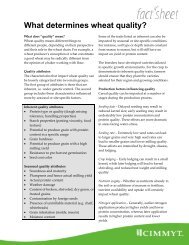

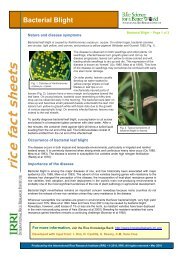

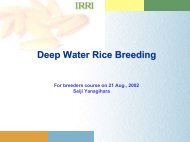
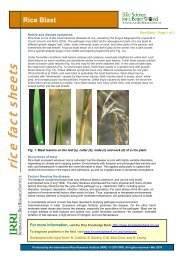
![International Standards' Organization â Rice Specification [ISO 7301]](https://img.yumpu.com/36696862/1/190x245/international-standards-organization-a-rice-specification-iso-7301.jpg?quality=85)

